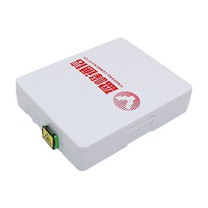Selection principle of direct buried optical cable
1. The optical characteristics of the optical fiber in the optical cable must meet the requirements for use
2. The mechanical properties of the optical cable must meet the requirements for use
3. The temperature characteristics of the optical cable must meet the requirements for use
4. After the optical cable is transported, constructed, maintained and applied, the optical fiber transmission characteristics will not be affected
5. Fully consider economic rationality
Environmental factors that should be considered in the selection
1. Whether there are AC electrified railways and high-voltage transmission lines in the routing area
2. Whether there is lightning damage, flood disaster, rodent damage area
3. Temperature and depth of frozen soil over the years
4. Promulgation status of mountainous areas, hills, flat land, water net rice fields, etc.
Selection of structure
According to the optical cable selection principle and the environment of multiple laying sites, the optical cable is generally required to be able to withstand greater lateral pressure and tension, be able to adapt to a large range of temperature changes, and be waterproof, lightning-proof, and anti-rodent bite.
Cable core (loose tube fiber): The direct-buried fiber optic cable has a large range of environmental temperature changes and complex conditions affected by external forces. When selecting an optical fiber structure, temperature characteristics and mechanical characteristics should be considered first. Because the loose tube fiber structure has a larger free movement range in the sleeve, it can basically offset the influence of temperature changes, and the attenuation value does not change within the range of -30~+70℃. When the loose tube fiber is subjected to lateral pressure, the fiber does not directly bear the action of external force; when it is stretched under tension, the fiber has a large margin for adjusting the length change, and the loose tube fiber is firmly selected.
No copper is added to the cable core: The copper wire is added to the cable core for the purpose of remote supply, but the relay distance has reached tens of kilometers, and the location of the relay station is mostly close to the township. There is no copper wire in the optical cable to prevent lightning strikes, avoid electromagnetic interference, and avoid hydrogen generation due to moisture and electrolysis of the copper wire, which will increase the attenuation of the optical fiber and reduce the life of the optical fiber. If the copper wire is added to the cable, not only the superiority of the optical cable is lost, but the cost of the optical cable is increased. There is no copper wire in the core wire of the long-distance optical cable, and the equipment can be powered by a combination of solar energy, storage battery and city electricity.
Filling grease: In order to maintain the stability of transmission quality, the reliability of communication and the safety of use, it is necessary to prevent the intrusion and penetration of water molecules into the optical cable. The filling grease method is to fill the gap between the optical cable and the fiber core with grease. The physical properties of the ointment are that it does not flow at high temperatures and does not solidify at low temperatures, and does not affect the transmission characteristics and mechanical strength of the optical fiber, and has reliable moisture resistance.
Inner sheath: The basic consideration of the direct-buried optical cable sheath structure is to protect the cable core from damage in the transverse direction of machinery and the environment. Adopting aluminum-plastic bonded polyethylene sheath structure can effectively prevent moisture and water and adapt to the environment.
Armored outer sheath: In order to prevent damage caused by digging tools, sharp corners of stones and animal bites, the optical cable needs an armored layer. The outer sheath is made of black polyethylene.
Central reinforcement: mainly to prevent the fiber from breaking due to the tension of the optical cable exceeding the tension that the optical fiber can withstand. The material of the stiffener must have a larger tensile strength and a larger Young's modulus, and a metal stiffener configuration is generally adopted. If there is a long distance parallel to the high-voltage transmission line in the route, in order to avoid or reduce the influence of strong electricity, FRP can be considered, and the sheath is still steel tape armor and PE outer sheath.






